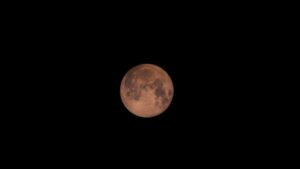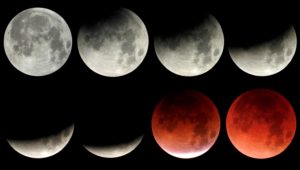
Image Credit: Giuseppe Donatiello from Italy
One of the most dramatic and easily viewed celestial events—a total lunar eclipse—is fast approaching. It happens on January 20-21 and will be visible from across North and South America (in Flagstaff, the majority of the action takes place late on the 20th). The Internet is rife with stories information about the eclipse, calling it a “super blood wolf moon total eclipse” or some variation of those words. While these descriptors are scientifically dubious, they have become popular in the media.
First, let’s look at the science of eclipses. Lunar eclipses occur only when the Moon is in its full phase whereas solar eclipses take place only when the Moon is new. A full Moon happens when it is opposite the Sun, with Earth in between the two bodies. Thus, when the Moon is full, it will be rising on the eastern horizon as the Sun is setting on the western horizon. The alignment of the three bodies is usually a bit off kilter but occasionally, the three line up just right so that Earth is in the path of the Sun and blocks its light from reaching the Moon. The result of the Moon’s passing through Earth’s shadow is a darkening of the Moon, or lunar eclipse. The deeper into the shadow the Moon moves, the greater the eclipse. If the entire surface of the Moon moves into shadow, then a total lunar eclipse occurs.

Image Credit: NASA
During a lunar eclipse, Earth’s shadow consists of two parts, both of which will be visible during the January 20-21 event. The penumbra is the lighter, outside portion of the shadow. It will be visible at 8:10 p.m. on the 20th (all times given here are for Flagstaff), though the shadow is faint and difficult to detect. The umbra is the darker, central part of the shadow. Its appearance is far more prominent and, for most people, indicates the true beginning of the eclipse. It will appear at about 8:34 p.m. This shadow will enlarge and pass across the Moon until 9:41 p.m., when the Moon will be completely in the shadow of Earth and thus totally eclipsed. Totality will last 63 minutes, ending at 10:44 p.m. The Moon will then slowly brighten as the shadow continues to migrate, until 11:51 p.m. when the umbra disappears. This indicates the end of the eclipse as most people think of it, though the faint penumbra will still be present until 12:15 a.m. on the 21st.
Chinese observers apparently made the first written record of a lunar eclipse in 1136 B.C., though eclipse mythology existed hundreds of years before this. Most early explanations for the phenomenon were absurd in the light of modern science. Monsters and spirits of various forms were frequently blamed. In around 520 B.C., the Greek philosopher Anaxogoras revealed the true cause. For his troubles, he was labeled an atheist and thrown in jail.
Other early observers noticed Earth’s shadow was crescent-shaped, proving that Earth is spherical. If it was flat, its shadow could not be crescent-shaped but would instead be straight.

Image Credit: NASA
Predicting eclipses is relatively easy and has been done for centuries. Hank Morgan, the fictional Connecticut Yankee in King Arthur’s Court, achieved a place of status in sixth century England when he correctly predicted a total solar eclipse in Mark Twain’s classic tale. A real character, Christopher Columbus, used his knowledge of an upcoming total lunar eclipse to settle a dispute with native Jamaicans. On Columbus’s fourth voyage to the New World, in 1504, he and his crew were stranded on Jamaica for more than a year. A feud between the crew and natives developed, and Columbus knew he had to settle it before lives were lost. Probably by checking an almanac, Columbus knew that a total lunar eclipse would occur on March 1. That night, he gathered the natives and told them that the “Almighty” was going to take away their Moon because of the natives’ poor relations with the sailors. Later, as the Moon was eclipsed, the natives apparently were horrified and begged for forgiveness, promising to be friendly if only the Moon was returned. Lo and behold, it did come back and peace was restored.
As for the many descriptors used in the media when discussing this eclipse, they are scientifically dubious though most are based on real characteristics. Since the Moon orbits Earth in a slightly elliptical path, the distance between the two bodies varies. When they reach their closest approach to each other—a point known as perigee—the Moon appears a bit larger and brighter than when it is farther away (this one will appear about 7% larger than average, which is practically indistinguishable). Some years back, an astrologer started using the term “supermoon” to describe this close approach, though he never defined the precise distance. The word soon became popular. Some astronomy experts have tried establishing distance parameters (usually between 222,000 to 223,000 miles), though most people now simply define it as a full or new Moon that happens near perigee.
Much like the term supermoon, blood Moon is another perverse term of recent origins. It’s linked to total lunar eclipses, when the Moon passes through Earth’s shadow, but has multiple interpretations. The first refers to a tetrad of lunar eclipses, meaning four consecutive eclipses that are all total. Some people have read religious meaning into this sequence, seeing the tetrad as some sort of prophecy. They thus gave a special name to these eclipses, calling them blood moons.

Image Credit: Lowell Advisory Board member Michael Beckage on January 31, 2018.
The last lunar tetrad occurred in the years 2014-2015 (as luck would have it, the world didn’t end despite the appearance of these blood moons). The next will be in 2032-2033. So why are some stories in the media calling the January 20 eclipse a blood Moon? Because of the second, less common, interpretation of the term blood Moon. During a total lunar eclipse, sunlight that is refracted, or bent, around Earth and onto the Moon will give the Moon an orange or red color. Some people thus call any total lunar eclipse a Blood Moon.
The last descriptor, wolf, is a common nickname for a full Moon in January, bestowed by ancient cultures perhaps based on their observation that wolves could often be heard howling in the winter.
So here we have some suspect terms with which we now seem stuck. In any event, the upcoming eclipse is a wonderful opportunity to observe the interplay of the Sun and Moon with our home planet.
The eclipse will be easy to view (if clouds don’t obscure the view) since they can be seen without the use of any special equipment. However, binoculars or a telescope will still offer a fascinating view, revealing craters, mountains, and other features moving in and out of Earth’s shadow. Lowell Observatory is hosting a special event on the 20th from 8 – 11 p.m. This will include special presentations about eclipses and viewing the event through the 24-inch Clark and other telescopes. For more information, visit the Web site at www.lowell.edu.